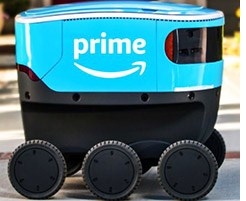Delivery Robots Nudging in on Sidewalk Traffic
A growing fleet of tiny, last-mile delivery robots are beginning to hit the sidewalks in Beijing, London, Seattle and other busy international cities, Scientific American reports.
A growing fleet of tiny, last-mile delivery robots are beginning to hit the sidewalks in Beijing, London, Seattle and other busy international cities, Scientific American reports.

Starship Technologies, a San Francisco-based startup says, its $5,500 robots have made more than 25,000 deliveries in various pilot programs in recent years. Online retail giant Amazon Inc. is launching tests this year near Seattle with its Scout device, a robotic six-wheeled unit (left) about the size of a portable ice chest cooler.
Citing a recent McKinsey & Co. study, Scientific American notes that autonomous robots can cut delivery costs by as much as 40% over typical delivery vans. They also help reduce street congestion and avoid the potential of double-parked vehicles blocking crosswalks, fire hydrants and bike lanes.
But there also are several challenges, including the potential of a package being stolen and pedestrians otherwise interfering with or damaging a robot. In addition, the automated devices must be able to traverse uneven sidewalks, avoid myriad obstacles and do so without disrupting pedestrians and bicyclists. This can be extremely difficult in busy downtown areas, analysts say, noting that San Francisco temporarily banned sidewalk robots in 2017.
Other delivery alternatives also are starting to emerge, such as Nuro Inc.’s street-legal autonomous pod. About half the width of a compact crossover vehicle, the pod is being used by Kroger to deliver groceries in a test program in Scottsdale, Ariz.
Increased competition is likely with retail deliveries growing by 16% in the U.S. during 2017. But with the high initial costs of a delivery bot, old fashioned bicycles remain one of the most effective ways to make last-mile deliveries, a previous McKinsey study points out.
RELATED CONTENT
-
Increasing Use of Structural Adhesives in Automotive
Can you glue a car together? Frank Billotto of DuPont Transportation & Industrial discusses the major role structural adhesives can play in vehicle assembly.
-
Choosing the Right Fasteners for Automotive
PennEngineering makes hundreds of different fasteners for the automotive industry with standard and custom products as well as automated assembly solutions. Discover how they’re used and how to select the right one. (Sponsored Content)
-
Multiple Choices for Light, High-Performance Chassis
How carbon fiber is utilized is as different as the vehicles on which it is used. From full carbon tubs to partial panels to welded steel tube sandwich structures, the only limitation is imagination.








